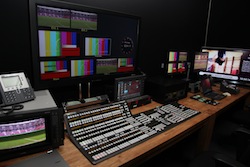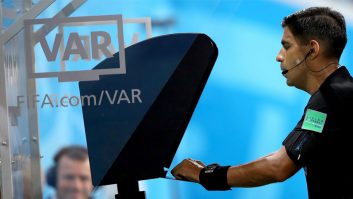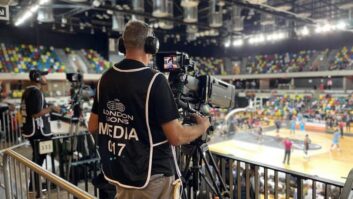
A remote production trial which could potentially change the way OBs are managed, has been initiated by UEFA for Euro 2012 and organised by Grass Valley supported by Media Links adaptation and transmission equipment. For the first time a true remote production is being demonstrated, with cameras and microphones in the stadium but all the rest of the equipment – switchers, camera control and so on – at a remote location. Klaus Weber of Grass Valley explained the set-up. “UEFA is very keen on the idea of remote production, and saw a demonstration at our Weiterstadt facility. They recognised that the technology was well developed, and were very keen to try it out for real. “The original intention was to cover a game in Ukraine with production control in the UEFA Euro2012 IBC in Warsaw, but it was too late in the planning to be able to get the additional fibre circuit,” he said. “So the test covers two games in Warsaw. It is just a few kilometres across the city, but we can include the technology to simulate fibre distances of hundreds or even thousands of kilometres.” The tests use additional cameras in the stadium, including a Grass Valley LDK 8300 Super Slo-Mo camera. The camera base stations are located in a machine room but with no camera control. The video outputs from each camera feed into a Media Links fibre adaptor, and the two-way fibre circuits also carry the control signals and diagnostics to control panels in the International Broadcast Centre (IBC). Media Links is supplying the encoders and multiplexers. For conventional outside broadcast coverage of the games Media Links is providing uncompressed signal transport via fibre from the back of the truck to the IBC, and the additional cameras in this trial are also carried from the stadium to the IBC uncompressed. For full remote broadcasts, though, it is likely that some compression of the camera signals will be needed to minimise the fibre capacity. The Media Links equipment includes JPEG2000 encoding as well as data and dedicated audio services, meaning that this could be implemented immediately. Weber pointed out that moderate compression does not have an impact on the audience. “An EVS server, or a Grass Valley K2 Solo server, is at 100Mbps, so we accept a compressed signal. We think that, for remote production, 200 or 300Mbps is sufficient: if you can go to 300Mbps it appears transparent. Even with audio, intercom, control and return feeds, a 10Gbps fibre is enough for 10 to 15 cameras.” One of the key reasons for the test is to see how the latency through the system affects operations and users. The Media Links system provides the complete processing path in 1ms, plus any delays down the length of the fibre – approximately 5ms per 1000km. This is fast, but only the trial will determine the impact. The system also includes a return video feed. That would be useful, for example, if the remote production created a multilateral feed in the IBC rather than on site, but individual broadcasters wanted to use it along with their own cameras to create a unilateral feed. Weber felt that the Grass Valley cameras were particularly important in this trial, because they have good remote diagnostics and control connectivity along a common bus, the LDK Connect Gateway. This can control and manage any number of cameras, including a serial tally control from the Grass Valley production switchers over ethernet channels, which will run in parallel to the signals on the same fibre. Other data can be fed through the LDK Connect Gateway to make the interconnection tidy and reliable. Tallies, for example, are carried this way so that they do not suffer the latency of the encoding and encapsulation process. Another application for the remote production capability might be to a studio with robotic pedestals, whose control system could also be carried on the same platform. Ultimately, the system offers the potential to deliver operational savings with relatively minor changes to working practices. Controlling different stadium set-ups from one production control in an IBC is one application: outside broadcast companies could boost productivity by shooting one game conventionally from the stadium then covering a second match the same day just by plugging up the remote fibre links. “UEFA is investing in this trial because they see it has potential for the future,” Weber concluded. “They are testing the remote production system over two games at the Euros. The first is very much a technical trial, to see where the bottlenecks occur. The second is a chance for UEFA’s production and management team to see the potential and evaluate the exercise.”






